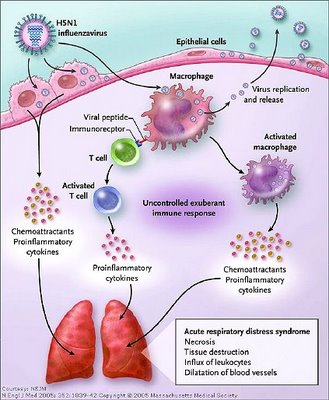Cytokine storm syndrome worsens COVID-19 outcomes
Apr 03, 2020
4451 Views
COVID-19 (or coronavirus (SARS-CoV-2) infection) is a pandemic of our times, with thousands of new cases being reported every day. According to some reports, the severity of the infection is greater in patients who experience an aggravated immune system response known as the ‘cytokine storm’
How does a cytokine storm occur?
Cytokines are the protein molecules that help in cell signalling. Cytokines are produced by immune cells like the B cells, T cells, macrophages and mast cells. These immune cells are important members of our immune system that help kill pathogens when they enter our body. Cytokines regulate the maturation, growth, and responsiveness of particular cell populations. Some cytokines enhance or inhibit the action of other cytokines in complex ways.
Cytokines have important roles in chemically induced tissue damage repair, in cancer development and progression, in the control of cell replication and apoptosis, and in the modulation of immune reactions such as sensitization. Cytokines such as HGF, IGF-1, TGF-α and IL-1, IL-2, IL-6 are associated with promotion of cell replication.
When an individual is infected by any pathogen (virus, bacteria, fungus etc..), their immune system reacts by producing the immune cells (white blood cells) which attack the pathogens and kill them. This is called the Second line of defense. These infections in humans are accompanied by an aggressive pro-inflammatory response and insufficient control of an anti-inflammatory response, a combination of events called a ‘cytokine storm’.
Also Read: The Immune system warriors: GAMED antibodies
In some cases there will be overproduction of immune cells and their activating compounds (cytokines), which, in a flu infection, is often associated with a surge of activated immune cells into the lungs. The resulting lung inflammation and fluid buildup can lead to respiratory distress and can be contaminated by secondary bacterial pneumonia — often enhancing the mortality in patients.
Several experiments and studies prove that cytokine storm is related to tissue inflammation which leads to damage of respiratory epithelial cells, which are the primary targets for the viruses.
During the primary infection, viruses proliferate within these cells and infect other cells, including alveolar macrophages. The inflammatory responses are triggered when the infected cells die by apoptosis (programmed cell death) or necrosis(cell death due to injury). The primary response of our immune system would be the acute inflammation and is characterized by increasing blood flow, which enables plasma and leukocytes to reach extravascular sites of injury/infected sites to kill those pathogen/infected cells. These responses can also be marked by the activation of pro-inflammatory cytokines or chemokines.
When the immune system is fighting pathogens, cytokines signal immune cells such as T-cells and macrophages to produce more immune cells and travel to the site of infection. In addition, cytokines activate those cells, stimulating them to produce more immune cells. Normally, this feedback loop is kept in check by the body. However, in some instances, the reaction becomes uncontrolled, and too many immune cells are activated in a single place, causing the immune storm/cytokines storm. This is generally referred to as the Cytokine Release Syndrome or CRS.

Also Read: The science behind Covid for the avid reader
CRS in COVID-19 patients
We all know that genetic differences contribute to individual variations in the immune response to pathogens. Human pathogenic coronaviruses ([SARS-CoV] and SARS-CoV-2) bind to their target cell (lungs, kidney, blood vessels) through angiotensin-converting enzyme 2 (ACE2), which is expressed by epithelial cells of the lung, intestine, kidney, and blood vessels.
These infected cells induce innate inflammation in the lungs that is largely mediated by pro-inflammatory macrophages and granulocytes. Lung inflammation is the main cause of life-threatening respiratory disorders(asthma, shortage of breath) at the severe stage.
The cytokine release syndrome (CRS) seems to affect patients with severe conditions (mainly autoimmune diseases). Since lymphocytopenia (abnormal levels of lymphocytes in blood) is often seen in severe COVID-19 patients, the CRS caused by SARS-CoV-2 virus has to be mediated by leukocytes other than T cells, as in patients receiving CAR-T therapy; a high WBC-count is common, suggesting it, in association with lymphocytopenia, as a differential diagnostic criterion for COVID-19. In any case, blocking IL-6 may be effective. Blocking IL-1 and TNF (cytokines) may also benefit patients. Although various clinical sites in China and across the globe have announced the use of stem cells in severe cases with COVID-19 infection, results are yet to be seen.
Lung damage is a major hurdle to recovery in those patients with severe COVID-19 infection. Through the production of various growth factors, stem cells may help repair the damaged lung tissue. It is important to mention that vitamin B3 (niacin or nicotinamide) is highly effective in preventing lung tissue damage, while vitamin C, vitamin D, zinc, magnesium help boost the immune system. It might be a wise approach to supply these food supplements to the COVID-19 patients.
Also Read: An Upcoming Covid 19 Risk & Immunity Report For All Genomepatri Customers
Do genes play a role?
Yes. Genetic factors can increase one’s likelihood to suffer from an hyper responsive immune system, or cytokine storm.
Mapmygenome is introducing a DNA-based COVID-19 Risk & Immunity report – this is a comprehensive genetic assessment of factors which affect COVID-19 susceptibility and severity:
- Nutritional parameters
- Immune response
- Drug response
- Health risks (eg., heart disease, diabetes, blood pressure)
And more….
References
- https://www.ncbi.nlm.nih.gov/pmc/articles/PMC3294426/
- https://www.thelancet.com/journals/lancet/article/PIIS0140-6736(20)30628-0/fulltext
- https://www.uchealth.org/today/zinc-could-help-diminish-extent-of-covid-19/
- https://jitc.biomedcentral.com/track/pdf/10.1186/s40425-018-0343-9
- https://spectrum.ieee.org/the-human-os/biomedical/devices/stem-cells-covid19-china
